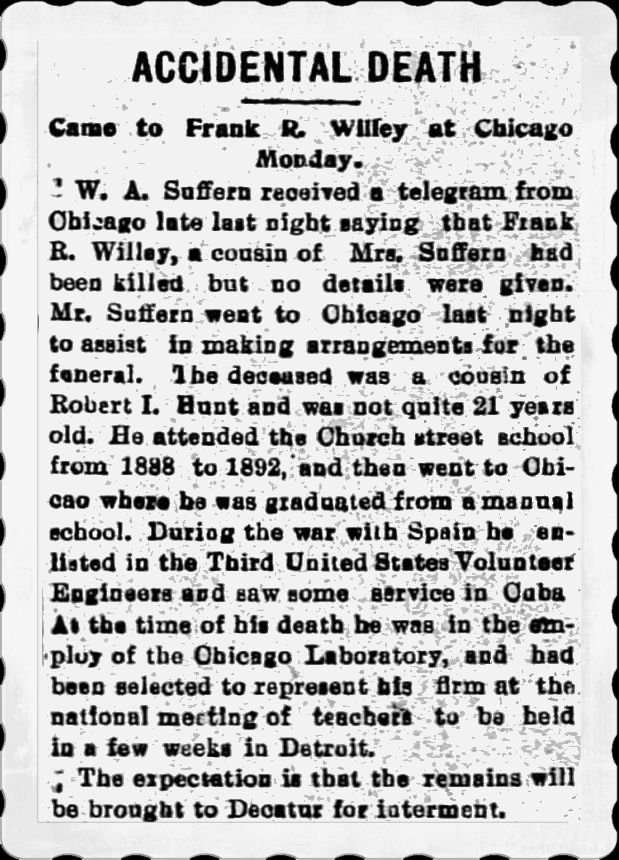
DIVISION 3
formally - DIVISION 2
LOT : 97
ROW : 10
COLUMN : 13
SUB. R/C : ?
GRAVE # 3

|
Frank Reuben Willey
b. October 7, 1880
Pierson Station, Piatt County, Illinois
d. June 10, 1901
Chicago, Cook County, Illinois
buried: June 12, 1901

|

FATHER
Reuben S. Willey
(1823-1888)

MOTHER
Mary Narsissa (nee-Hunt) Willey-James
(1844-1941)

NEVER MARRIED
|

NO CHILDREN
|
|

NOTE:
Frank Reuben Willey,
served in the
SPANISH-AMERICAN WAR
3rd U. S. Vol. Engineer Ring Corps
|
NOTE:
Frank's father,
Reuben S. Willey,
fought in the
CIVIL WAR
|
NOTE:
Frank's grandfather,
George Washington Hunt,
fought in the
CIVIL WAR
|
|
3RD U.S. VOLUNTEER ENGINEERS
The Third U.S. Volunteer Engineers was part of
the First Corps' Third Division. The regiment, one of only three of its type raised during the war,
was quite unique in the level of technical ability that was concentrated in the regiment. Only one
company of the 3rd saw action, serving in Puerto Rico.
Unit History
Gaillard. The unit was authorized by act of Congress on May 11, 1898. On June 6, 1898, orders were
issued indicating that the Third Regiment was placed under the command of Col. David DuB. Gaillard.
Gaillard had entered West Point in 1884 and had graduated with honors. Later in life, Gaillard would
become the man in charge of digging portions of the Panama Canal, including the Gantun Lake and
Culebra Cut, later called the Gaillard Cut. Initially, the unit's headquarters were located at 2728
Pennsylvania Avenue, Washington DC.
The men who served under Gaillard were required to be from the south and southwest: Virginia, West
Virginia, North Carolina, South Carolina, Kentucky, Tennessee, Missouri, Arkansas, Georgia, Florida,
Alabama, Mississippi, Louisiana, Texas, The Indian Territories, Oklahoma, New Mexico and Arizona.
The unit was ordered to rendezvous at the Jefferson barracks near St. Louis, Missouri, which was
somewhat central to the district.
The orders were to recruit men from "every branch of the engineering profession and of mechanical
skill. Machinists, steam engineers, blacksmiths, carpenters, plumbers, telegraphers, topographers,
draftsmen, photographers, railroad men, riggers, boatmen and those skilled in the use of explosives
are especially desired." Applicants had to be between 18 and 45 years of age and "of good character
and habits, able-bodied, free from disease" and able to speak English. Single men were preferred,
with married men having to obtain special permission from the commanding officer of the regiment in
order to join. Officers, such as Gaillard, were to be chosen for their skill in military, civil,
electrical, mechanical or topographical engineering and were appointed by the Secretary of War.
The unit was mustered into service between July 25 and August 20, 1898 at th Jefferson Barracks in
Missouri. At the time of mustering in, the unit consisted of fifty-three officers and 1,094 enlisted
men. Each of the unit's twelve companies was to have 86 men, including three officers. The common
private received between $15.60 and $20.40 per month. Corporals made $24 per month, and sergeants
$40.80 per month.
The men were to be armed, equipped and drilled as infantry in addition to their engineering duties.
The term of enlistment was two years.
Recruiting for the engineers apparently went fairly well, and all three regiments of volunteer
engineers were filled by August 20, 1898. However, the war had essentially ended on August 12.
The Third Regiment was sent to Camp Thomas, on the old Chickamauga Civil War Battlefield in Georgia.
One company of the 3rd was sent to Puerto Rico as part of the invasion force and saw action around
Coamo. However, the majority of the unit remained behind in the U.S. during the majority of the war
itself. All companies eventually saw service overseas, however.
As the threat of disease became more obvious, and disease epidemics broke out, nearly 5,000 of the
43,000 men at Camp Thomas were ill. To improve their health, the Third Division of the First Army
Corps was ordered to Lexington, Kentucky on August 21-22, 1898, and this is where the unit remained
as of October, 1898. It may have been sent further south as winter approached.
The company which was sent to Puerto Rico was from Florida and under the command of Maj. J. W.
Sackett. Beginning on June 12, the unit began training in infantry drill, as well as in the
construction of pontoon piers, the unloading of artillery on rafts, etc. On July 10 - 11, 1898, the
company and its pontoon train was loaded onto the transport LAMPASAS, and by July 20, it was in
Cuba. Here, it built and disassembled a pontoon pier in one day. On July 25, the unit disembarked at
Guanica, where it used its infantry drilling to aid in clearing the town of Spanish troops. By 1:00
p.m., the unit was relieved of infantry duty and began the construction of a pier. By 11:00 p.m.,
the pier was completed an all of the stock unloaded. On July 30, the unit was transferred to Ponce,
and began bridge building at Coamo and Guayama.
|

The Decatur Herald
(Decatur, Illinois)
11 JUN 1901 * page 1
|

The Decatur Herald
(Decatur, Illinois)
13 JUN 1901 * page 2
|
|
| |